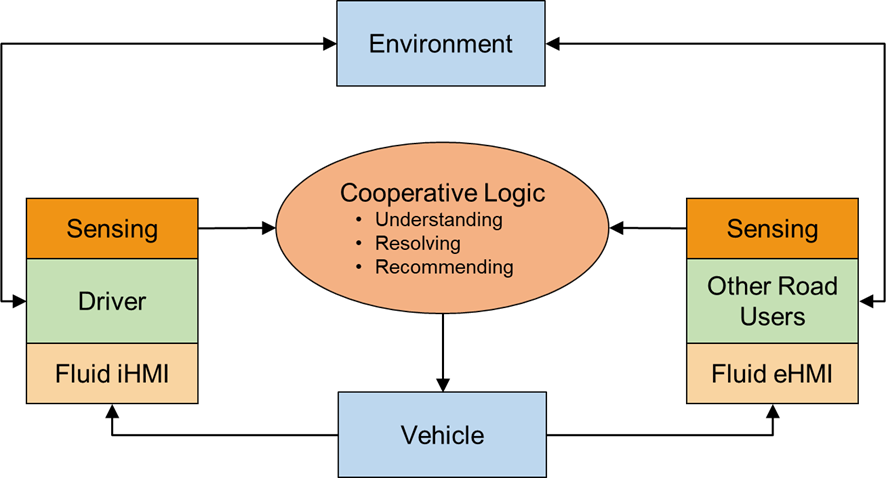The Project
HEIDI in a nutshell
In most current cars, human–machine interfaces (HMI) have limited understanding of the intentions of pedestrians and vehicles in the surroundings. This can lead to pedestrians being exposed to dangers and drivers being presented with distracting warnings. The HEIDI project aims to develop a fluid, cooperative HMI that holistically integrates internal and external sensing to create adaptive HMI solutions for drivers and other road users. This cooperative HMI effectively gathers and synchronizes driver’s data and data from other road users to i) understand the situation and ii) recommend safe joint actions to all stakeholders. The coordination logic conforms to the principle of Foresight Safety®, i.e., the human-like ability to anticipate hazards and proactively avoid dangerous situations. Heidi’s HMI solutions guarantee that all road users have the same understanding of the situation and ensure safe interaction between vehicles and vulnerable road users. Fluid internal and external interfaces coordinate information and joint-action recommendations addressing all user categories, while adapting to their respective states and conditions like, e.g., distracted drivers and older pedestrians.

Objectives
1 – Develop and demonstrate fluid, cooperative HMI
The HEIDI project will develop new concepts of holistic and adaptive HMIs targeting the safe interaction between drivers and pedestrians. Protoypes will be validated in a multi-user simulation environment and in real vehicles. Internal and external HMI solutions will be integrated into a cooperative HMI, which synchronises action recommendations for drivers and other road users.
2 – Develop technical innovation for mutual awareness between road users and drivers
The HEIDI project will develop i) a driver monitoring system which detects critical driver states in real time, extended by driver behaviour prediction, ii) a pedestrian monitoring system which detects road user type, attentional level and overall capability in real time, while providing the most likely future behaviours, iii) a situation assessment and decision module which identifies and addresses interaction partners by suggesting a safe joint behaviour based on combined sensed inputs, and iv) a situation resolution and tracking module which continuously tracks whether the recommended joint actions are followed and triggers HMI countermeasures if needed. An osmotic software layer will enable fast and efficient data processing and HMI updates for the above solutions.
3 – Develop suitable validation methods for assessing cooperative HMI solutions
Specific multi-user simulation environments and research methods to evaluate the safety, usability & effectiveness of the cooperative HMI solutions will be developed and validated based on defined use cases. Current infrastructure will be improved to develop novel simulation-to-reality transfer methods for perceptual systems and to support the homologation of human-centred HMI-based safety systems. Finally, catalogues of ethical guidelines for multi-user tests sharing traffic participants information will be produced.
4 – Recommendations for regulation and standardisation of adaptive internal and external HMIs
Two sets of guidelines and recommendations will be produced for i) regulation and standardisation bodies, namely EuroNCAP and IEEE, especially targeted towards external HMIs as the situation on specific regulations and standardisation is still unclear and ii) a catalogue describing the human-centred methodology which has been applied in the HEIDI project that allows technology providers to work closely with multiple stakeholders in a systematic way to create holistic HMI systems, where multiple traffic participants are considered.
Innovations
- Fluid design of human-machine interactions: Information flows and adapts to user
- Osmotic software layer for wireless, continuous update of “meta-knowledge” and vehicle HMI
- Adaptive tutoring system supporting, e.g., elderly drivers with learning difficulties
- eHMI (external human-machine interface) to allow automated vehicles to communicate and interact with vulnerable road users (VRU)
- Cooperative decision module for situation recognition and joint action recommendation
- Sensing and prediction algorithms for different users, abilities, states and intentions
- Multi-user co-simulation set-up to safely evaluate cooperative road users’ behavior
- Human-centered methodologies for evaluating safety, usability and effectiveness of multi-user HMI
- Foresight Safety approach to prevent the occurrence of dangerous situations like humans do
